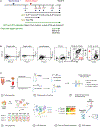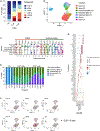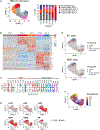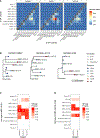Tracking B cell responses to the SARS-CoV-2 mRNA-1273 vaccine
- PMID: 37440409
- PMCID: PMC10529190
- DOI: 10.1016/j.celrep.2023.112780
Tracking B cell responses to the SARS-CoV-2 mRNA-1273 vaccine
Abstract
Protective immunity following vaccination is sustained by long-lived antibody-secreting cells and resting memory B cells (MBCs). Responses to two-dose SARS-CoV-2 mRNA-1273 vaccination are evaluated longitudinally by multimodal single-cell analysis in three infection-naïve individuals. Integrated surface protein, transcriptomics, and B cell receptor (BCR) repertoire analysis of sorted plasmablasts and spike+ (S-2P+) and S-2P- B cells reveal clonal expansion and accumulating mutations among S-2P+ cells. These cells are enriched in a cluster of immunoglobulin G-expressing MBCs and evolve along a bifurcated trajectory rooted in CXCR3+ MBCs. One branch leads to CD11c+ atypical MBCs while the other develops from CD71+ activated precursors to resting MBCs, the dominant population at month 6. Among 12 evolving S-2P+ clones, several are populated with plasmablasts at early timepoints as well as CD71+ activated and resting MBCs at later timepoints, and display intra- and/or inter-cohort BCR convergence. These relationships suggest a coordinated and predictable evolution of SARS-CoV-2 vaccine-generated MBCs.
Keywords: B cells; BCR repertoire; CP: Immunology; SARS-CoV-2; immunological memory; mRNA vaccine; single-cell profiling.
Published by Elsevier Inc.
Conflict of interest statement
Declaration of interests S.H.K. receives consulting fees from Peraton. K.B.H. receives consulting fees from Prellis Biologics.
Figures






References
Publication types
MeSH terms
Substances
Grants and funding
LinkOut - more resources
Full Text Sources
Medical
Molecular Biology Databases
Research Materials
Miscellaneous

